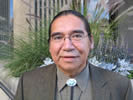MI'KMAQ ELDER BIOGRAPHY
Stephen Augustine

I’m from Big Cove, which is on the north shore of the Richibucto River in New Brunswick, in the Signigtog District of the Mi’kmaq nation. The name ‘Big Cove’ was changed two years ago to Elsipogtog, which means “The Path of the Great Fire,” as in the Great Spirit fire. In our Creation story, the path of the Great Fire refers to how the seven clans of the Mi’kmaq dispersed in the Maritimes, each to their own district. And those clans are all responsible together for assembling and tending to that Great Spirit Fire, from which they all originated.
I am a hereditary chief of one of those seven clans, from the Signigtog region, and also work as a curator at the Canadian Museum of Civilization.
I speak the Mi’kmaq language but I also understand the Maliseet language, and French and German. When I hear a Maliseet or Montagnais Innu person speak, I can pretty well understand what they’re talking about. They are very similar to us, because they are our neighbors. The Mi’kmaq people in Restigouche, in the Gaspe region of Quebec, have a lot of words that are similar to the Montagnais people. And if you go down to Big Cove, a lot of the words are similar to Maliseet words, because they were our neighbours. The Algonquian based languages - Blackfoot, Cree, Saulteaux, Anishnabek, Atikamekw, Mi’kmaq, Maliseet and Beothuk, for example, are all related, just like Latin would be related to Italian, Spanish, French, or Portuguese.
As for the word Mi’kmaq, there is no such word in our language. Nigamaw is the more appropriate term. Nigamaw means something like, “I am related to that person.” My sense of the word Mi’kmaq is that it originates with the arrival of the French who most likely failed to understand what was meant by the reference to Nigamaw, or “our relations,” when they questioned the people about the surrounding communities.
I received my traditional education from my elders. When my grandfather passed away in 1956, my grandmother Agnes spent a lot of time with us. She was born in a wigwam on June 14, 1898 in Lennox Island, Prince Edward Island. She grew up traveling with her parents and family from one community to another and living off the land, looking for places where certain fish would be abundant, or making baskets and selling them. That was the only economy that our people could rely on at that time, because our traditional ways of survival on the land were becoming very limited. And between 1900 and the 1920’s there was no real assistance from the government for the Indians. They were able to get tea and sugar and flour from local stores that were subsidized by the colonial governments. In this way they were able to more or less get the basics that they were beginning to rely on more and more.
My grandfather, Basil Tom Augustine, was born near Moncton in the early 1860’s. He was a direct descendant from Michael Augustine, who signed the treaty of 1760, which ended hostilities between the French and the British, agreeing that the Mi’kmaq would stay neutral. So they signed a treaty of peace and friendship; they didn’t surrender any of their land. This was all recorded on our wampum belt, which is a mnemonic device made out of quahog shells and blue and purple beads. We used the wampum belts to record the story of the treaty, and to record sacred teachings like the creation story. Part of the responsibility that hereditary chiefs have is to carry the sacred bundles of our ancestors, and to carry the stories that accompanied those bundles.
So these teachings have been passed down. My grandfather received his teachings from his father, who in turn received them from his ancestors before him. And part of our family responsibility, which comes with our sacred bundles and teachings, is to learn and understand and pass on this knowledge and these ceremonies – beginning with the sweetgrass ceremony, the tobacco offering ceremony, the pipe ceremony, and the sweat lodge ceremony. These ceremonies and our language are all part of our traditional education; they teach us about our own systems of knowledge.
So I will share something of what I have learned from my Elders, through our Creation story.
In honor of my elders, wela’lin – thank you.